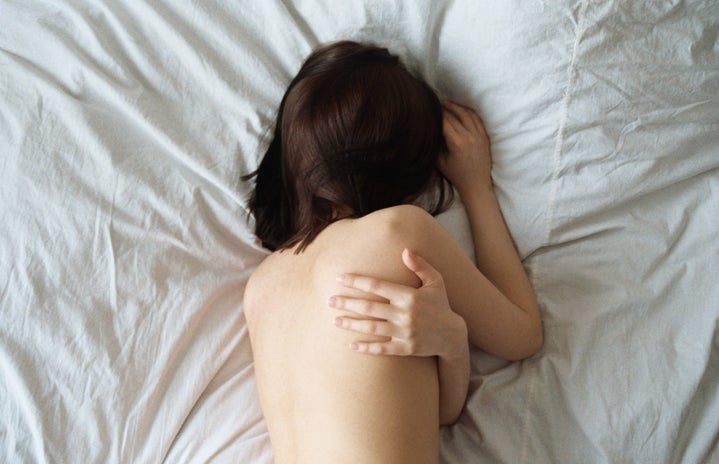Since I was in 5th grade, I have struggled with something called Scoliosis. What is Scoliosis, you ask? It’s an abnormal curvature of the spine. Treatment may require wearing a prosthetic back brace or getting spinal fusion surgery. I experienced both.
Scoliosis is something that affects my life everyday. And it will for the rest of my life. For how common my doctor says it is, I am surprised how little people know or talk about it. I am also surprised at how little information is out there.
So, I decided to write about my experience with Scoliosis. The good. The bad. The ugly. How it has affected all different aspects of my life. Warning: It’s blunt AF. Here it is:
(DISCLAIMER: I am not a doctor, nor am I studying to be one. This is all from my experience. My opinions. My knowledge. Also ask a professional first!)
Diagnosis:
How is someone diagnosed with Scoliosis? When the doctor asks you to bend over and touch your toes. That is a test to see if you have any back issues i.e. Scoliosis. If they notice something, they will ask you to see an Orthopedic and then they will make the final diagnosis. If you can already touch your toes, like most humans, you’re probably less severe. I was never able to toe my toes, and I have severe Scoliosis, so that may give you a sense of range.
Severity:
There are many different types of severity when it comes to Scoliosis. The most severe requires a curvature of above 50 degrees and a spinal fusion surgery, where they install metal rods inside your back in order to straighten the spine as much as possible. The least severe only requires a watchful eye, to make sure it doesn’t get any worse. Like I said before, I was on the more severe end of the spectrum. Everyone I meet who also has Scoliosis, I always have it worse then them.
Causes:
My theory for myself is that I didn’t stick with ballet lessons throughout my 10 years of being a dancer. I also taught myself how to do a back walkover with no professional guidance. I think both of these contributed to my severe Scoliosis. However, there isn’t a definite known ‘cause’. However, most of the time, it’s family history. However, no one that I am aware of in my family has ever had Scoliosis, so I don’t know. But there is no definite cause for it.
History, Facts, and Statistics:
Scoliosis is five times more likely in girls than boys. And from my knowledge, it gets diagnosed most likely between the ages of 10-15. I was diagnosed around age 10, braced until age 14, and had surgery at 16.
Scoliosis was first described around 400 BC by Hippocrates and had its first recorded treatment in the 16th century or 1500s. 100% of patients struggle with coordination, balance, and dysfunction. They also all struggle with spinal pain that inhibits when doing physical activity. Hence why I am not an all-star cheerleader anymore, if ever.
90% of individuals living with Scoliosis with psychological problems and unhappiness. I’ll explain later how Scoliosis has influenced my struggles with anxiety, depression, and body dysmorphia. 70% of advanced Scoliosis cases have rib hump and 80% of women develop chronic menstrual irregularities. Also Scoliosis affects 15-20% of the world’s population, and severity ranges in this statistic. Scoliosis affects your breathing, heart, head, neck, walking, and ability to do literally anything. It causes severe pain. It’s not just your spine. This is because the ‘headquarters’ of your body is your spine and your brain, so when one (or both since I have mental health issues too that derive from Scoliosis) are messed up, it’s hard for the rest of the body to work right.
In 8 out of 10 cases, or about 85%, the cause is unknown. This is called Idiopathic Scoliosis. 5 out of 6 Idiopathic Scoliosis patients are female. I have Idiopathic Scoliosis. Other types of Scoliosis are Neuromuscular Scoliosis (which is when there is an underlying muscular tone issue that then causes the spine to curve and twist), Congenital Scoliosis (which is a rare case when the spine begins to twist and curve in-utero), and Early On-Set, which is another rare type when it is diagnosed before the age of 10. Scoliosis can’t be prevented. 10% of Scoliosis diagnoses result in surgical treatment.
Awareness Month And Day:
National Scoliosis Awareness Month is June. Yes, it’s the same month as Pride month. Therefore, it is often overshadowed. But Pride month is still an amazing thing!
International Scoliosis Day is June 27th. Remember to celebrate! Wear green! Post on social media! Tag @cgscoliosis (a great organization) or myself @samigotskind.
Back Braces:
THESE! SUCK! They try to make it fun and cool by having different patterns and colors, but there is no light at the end of the tunnel. Except for the day the doctor says you don’t have to wear them anymore. They are uncomfortable. They are hideous. They are a pain in the ass. And they are incredibly hard to hide. If I had a dime for every weird look I got while in a back brace, I’d be richer than Bill Gates and Jeff Bezos combined.
You will probably end up having multiple back braces until your doctor requires surgery. The best part about wearing a back brace is taking it off. Which you have to do in order to eat, work out, sit on the floor (depending on your flexibility pre-Scoliosis), and go to the bathroom. The only other plus is the technological advancement they have made in back braces. They no longer go up to your neck, which is amazing if you have a fear of choking like me.
Surgery:
Again…THIS SUCKS! It’s painful. It’s terrible. And you will shit your pants. Your back is numb for about 10 weeks. You can’t shower by yourself. You have to relearn how to walk up and down the stairs. And you can’t sit or lay down with an array of pillows to support you. You spend about 5 days in the hospital, eating ice chips and not sleeping a wink. But at least you will look more normal and more even than you did before.
Surgery recovery:
The only plus is A) you will never have to wear a hunk of plastic again, and B) your dog will never leave your side. You spend 4-6 weeks at home, which is probably the best part if you are a homebody like me. I watched lots of General Hospital and HGTV, personally. Also I recommend oatmeal, tea, and lots of ice cream (it is technically Calcium). But after that, they start to encourage you to go out, like out to eat, which is the worst part, because you actually have to bring pillows with you IN PUBLIC to support your back. It’s humiliating. But at the end of it all, it will make you a much stronger person.
Media:
The only shows I can think of that mention Scoliosis are “That 70′s Show” and “Scream Queens”, and honestly, it was more of a joke rather than a sensitive and valuable education. And the only celebrity advocate is a freaking Victoria’s Secret model, Martha Hunt, which isn’t very relatable in my personal opinion. There is also Princess Eugenie, Queen Elizabeth’s granddaughter, who showed her scar at her wedding, which to someone like me, was so inspiring. So I hope in the future that more people will use TV, movies, and media to educate others on Scoliosis.
Mobility and Working Out:
Basically from what I gather, the amount of flexibility and mobility you have pre-surgery, will be the same amount you have post-surgery. So, if you are like me and have never been able to touch your toes, then you are pretty much screwed. There are all kinds of ‘inspirational’ stories about cheerleaders and athletes who have overcome Scoliosis, but really the fact of the matter is, you are not going to get any more flexible or mobile once you have the surgery. No matter how much you work out or stretch or whatever, those rods will only restrict you. I am not an athletic person, and having Scoliosis only makes my motivation to workout nonexistent. Physical therapy also only helps post-surgery in order to get back everything I had beforehand, nothing more and nothing less. For example, post-surgery you have to relearn how to walk up the stairs, sit on the floor, and get up from the floor. PT helps with all of that. Also the massages are pretty nice because they are directly catered to your back. Also cardio is the worst. Scoliosis causes my ribs to go into my lungs and make my lung capacity smaller, therefore when I run, I start wheezing and oftentimes I hyperventilate, especially I was forced to run a mile for P.E. I’m sorry if this is too blunt, but it’s the truth, and its time people are honest about it instead of blindly encouraging people without really knowing what it’s like. Now, I’m not saying that you shouldn’t still workout, you should. Its important for your overall health, but just know that it’ll be like 100x harder to get the ‘bikini body’ you want for Spring break.
Back Pain:
Some days are good. Some days are bad. but the bad ones are just UNBEARABLE. Back pain is something, even post surgery, that will be lifelong. Mine certainly hasn’t gone away post surgery, but it becomes manageable. You also learn what makes it worse, and how to live with it. And if someone tries to be empathetic by saying ‘I have back pain too’, like I am sorry, but NO YOU DON’T. You take one IbuProfen and you’re fine. We have these our WHOLE LIVES. But for people with Scoliosis, it only makes us stronger.
Remedies:
CBD. Foam rolling. Splurging on massages. Sleep. Heating pads. Medication. Hot showers. Other than that, not much helps, but being lazy and watching Netflix. On good days, working out helps, but on bad days, you are literally paralyzed. That might be melodramatic, but it feels that way. Different things work for different people.
Traveling:
You will be mildly assaulted by TSA at least once during a round trip. Maybe not at larger airports like in Chicago or New York, but it’s pretty much guaranteed at smaller ones like KCI. TSA is the worst with both a back brace and post-surgery. The metal detectors detect both and they are always suspicious, because what adolescent has metal in them, right? They always have to pat you down, or take you to a private room and inspect your back brace (because why not make myself more uncomfortable on this hour-of-hell flight to Chicago by smuggling weed in this hunk of prosthetic called a back brace?) And road trips aren’t much better because you are just sitting their in 9-hours of pain. My only advice is if you do have travel with Scoliosis, make sure its to somewhere exciting. I recommend New York City. Also treat yourself to some Starbucks and Melatonin (because sleep is the best medicine, right?)
School:
aka hell. Kids are mean. They always have no idea when they are staring. Also snapchat is the devil’s work, especially when you have to bring pillows to school post-surgery for back support. If I have a dime for every snapchat story I was on with my pillows captioned ‘relatable’ or ‘mood’, I’d be living on the Upper East Side right now. Pre-surgery, however, (with or without a brace) it looked like another human was poking out of me, especially because my brace went all the way up my shoulders. So kids basically ran for the hills. Okay, that’s a bit melodramatic, but seriously, some were just appalled to look at me. While others were only nice for sympathy points, which was honestly the worst. I also had to take it off before lunch everyday and I always had to awkwardly sit in a chair while the rest of my classmates sat on the floor. Basically, school and Scoliosis are not soulmates. They are the Dan Humphrey and Blair Waldorf of the high school experience. But, it will make you stronger, and if you plan to have a career in the public eye like me, hate comments and internet trolls will mean nothing to you after having Scoliosis during middle and high school. And in terms of homeschooling during recovery, it’s the best thing ever., especially because I’ve been begging to be homeschooled my whole life It’s all on your own time and it’s so much easier. Independent study is the best. And that’s probably why I’m thriving during online classes because of COVID-19. As long as you are communicative and have great relationships with your teachers prior, it should be a piece of cake. In college, it has gotten better. I will say I am grateful to have gone through it earlier. In college, it’s just about awareness, self care, and being outspoken, which after dealing with it in high school, is no big deal. I’m not saying it’s amazing in college, but it’s not like I hide it as much anymore.
Clothing:
If you are a self-proclaimed fashionista like me, having Scoliosis is basically a worse nightmare then wearing tights as pants. Pre-surgery everything is chunky looking due to your curvature, and forget dressing cute in a back brace, unless your style icon is Billie Eilish or Ariana Grande circa Sweetener era (my style icons personally are Audrey Hepburn, Madonna, Blake Lively, and Zendaya and none of them have Scoliosis), have fun wearing t-shirts for 5 years straight. Also whatever you do, DO NOT wear underwire bras, jeans, skirts, and non-seamless underwear because you will get painful, and I mean painful, skin markings. DO wear oversized shirts, leggings, athletic shorts and sports bras to both be as comfortable as possible and hide your back brace as much as possible. Also, some people don’t know what you have to wear tank tops under your back brace. I got white ones from Jockey. They make it more comfortable on the one hand, but on the other hand, it makes it so sweaty and makes the Summer so much hotter. However, post-surgery, don’t go crazy beforehand because you have no idea how little or how much your body will change for both better or worse. You will still have to hide it, and it will take some time before you wear anything too skin tight. Also, forget online shopping. You’ll waste your money and it’s a pain to do online returns constantly. You’ll have to try everything on. Also, certain styles of shoes are very difficult to get on. Overall, oversized is still the way to go. Fit and flare works best. Black hides all. High necklines are golden. And like Princess Eugenie on her wedding day, don’t be afraid to show that scar (unless its directly in the sun, you don’t want it to get sunburnt and therefore be permanently dark and huge). Patterns are good for tricking the eye. Also confidence is the best style tip. But fair warning, bras are impossible.
Sleep:
Some nights you will sleep like a baby, and other nights you will wake up at three different times for no reason. However, I compare sleeping in a back brace to how an astronaut sleeps in space. You feel trapped, suffocated and tied down. But out of the back brace, some nights, it’ll be the perfect remedy to days’ worth of back pain, while other nights it’ll be the reason you get zero sleep.
Social Life:
It’s hard. You can’t always do everything. And because of that you won’t really feel motivated to go out and be social. Or it might be the opposite, you’ll feel left out because people don’t want to deal with your pain and need for accommodations. It also depends on how much you use ‘The Scoliosis Excuse’ (which I recommenced to use as little as possible). I will say, it gets MUCH better post-surgery and post-recovery. I didn’t know who my real friends were until my surgery, and I learned how to find them too. So in this case, there is a light at the end of the tunnel.
Mental Health:
If you don’t have a mental health issue before you get diagnosed with Scoliosis, you will get one or more during the experience. I don’t say that to scare you. I say that in order not to sugar coat anything. Anxiety. Depression. Body Dysmorphia. I’ve dealt with it all, in and out of a back brace, pre- and post-surgery. Post-surgery, it’s the anxiety that has stuck. You will get through it though. Between the struggles with mental health and the struggles with Scoliosis, it will only make you stronger.
Body Image:
This by far the worst and most long-lasting residual effect of dealing with Scoliosis. You will feel terrible about yourself, especially while wearing a back brace pre-surgery. It gets better post surgery, but it’s still a never ending battle. Scoliosis affects your entire body. Your entire body is uneven. Legs. Arms. Waist. Wrists. Shoulders. Hips. Boobs. Everything. My shoulder blades poke out. And the media certainly doesn’t help with gaining confidence. It just takes time. I will say, while in the thick of it, I tried to hide as much as possible. Now that I’m done dealing with back brace, surgery and recovery, I’m less ashamed of it. I’m still insecure, but I’m not afraid of showing my scar or talking about it. But the body image issues, that never really goes away. But it does get easier. And some days are better than others. There’s not really much to say, it’s just something that will always be there. I mean, everyone is self-cautious, but with a disease that affects your entire body, body image issues are inevitably heightened.
General Difficulties:
If i’m being honest, almost everything is harder with Scoliosis in some way, shape, or form. The levels of difficulty are obviously different depending on what you’re talking about, but Scoliosis affects every aspect of someone’s life. But you get stronger. And it gets easier.
Things To NOT Say To Someone With Scoliosis:
-”Sit up straight”
-”Stop slouching”
-”It can’t hurt THAT bad”
-”Ew, what happened to your back?”
-***STARING***
-”Ouch, why did your stomach/shoulder just hurt me? It’s so hard. That’s no normal. What is wrong with you?”
-”Oh, I can’t even tell, so it must not be that bad”
-”Yeah, I have it mildly, and it hurts SO bad”
-”Oh, I totally get it, my back hurts too sometimes”
-”Physical therapy is easy”
-”Why can’t you just (eat spontaneously, sit on the floor, touch your toes, etc.) like everyone else?”
-”It’s all in your head”
-You are just being melodramatic”
-”Why are you so paranoid?”
-”That outfit look so big on you”
-”You probably just need to be more active and workout more”
-”You’re ALWAYS sick”
-”You just need to push yourself”
-”Your back would be fine if you just had better posture”
***We pay $4,000 for surgery and get better posture and grow 4 inches, so do your research.
-”Stop using it as an excuse”
-”you are such a party pooper, live a little”
-”Everyone has back issues”
-”Try stretching”
-”Maybe you should become a stoner and stop complaining”
-”RELAX! CHILL! CALM DOWN!”
-”If you can’t see it, then it’s not there”
-”Back pain is subjective”
Things TO Say To Someone With Scoliosis:
-”Wow, I couldn’t even tell”
-You look amazing!”
-”Are you okay?”
-”Do you need anything?”
-’Let me help you”
-”I am here for you”
-”You are valid’
-”Your pain is real”
-”Do what you can”
-”Do you want a massage?”
-”You are so strong”
-”You are such a hard worker, look how far you’ve come”
Thank you for reading and I hope this helped bring awareness to Scoliosis!
Remember that you bent, not broken!




